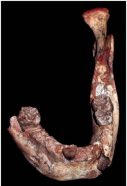Childhood’s long history
Our ancient ancestors had long childhoods, just as we do today.
Share this:
- Share via email (Opens in new window) Email
- Click to share on Facebook (Opens in new window) Facebook
- Click to share on X (Opens in new window) X
- Click to share on Pinterest (Opens in new window) Pinterest
- Click to share on Reddit (Opens in new window) Reddit
- Share to Google Classroom (Opens in new window) Google Classroom
- Click to print (Opens in new window) Print
By Emily Sohn
You’re lucky. Compared to other animals, you get to be a kid for a long time before you have to strike off on your own. Recent studies suggest that people have been enjoying long childhoods for many thousands of years.
Some of this research has focused on several human teeth found in Morocco in 1968. On the basis of earlier studies of the molecules in these teeth, scientists estimate that their owner lived 160,000 years ago.
 |
|
This jawbone came from a human child who lived 160,000 years ago. The child’s teeth grew in a way that suggests people have had long childhoods for a long time.
|
| Tanya Smith/Proceedings of the National Academy of Sciences |
In more recent studies of the Moroccan fossil, scientists from the Max Planck Institute for Evolutionary Anthropology in Leipzig, Germany, looked at a molar (back tooth), a front tooth that was just starting to grow, and a canine (sharp, pointed side tooth) that hadn’t yet broken through the gums. The researchers used a new X-ray technique to study these teeth and the hard substance called enamel that covers them.
As kids grow, new layers of enamel form on their teeth every 7 to 9 days. Growing teeth also develop growth rings that are similar to the growth rings in tree trunks. By counting layers and rings in fossil teeth, scientists can tell how old the teeth—and the child who owned them—were.
Using the new X-ray technique, the German scientists could count the layers and examine growth rings without damaging the teeth. In the past, scientists had to cut open teeth to count enamel layers and rings.
Results showed that the teeth belonged to a child who was 7 years, 10 months, old when he or she died. The fossil teeth looked just like the teeth of a modern 7-year-old. That suggests that kids who lived 160,000 years ago grew at about the same rate as modern kids do.
“The [new] study pushes back clear evidence for humanlike growth to 160,000 years ago,” remarks anthropologist B. Holly Smith of the University of Michigan in Ann Arbor.
In another study, a different group of scientists used a similar X-ray technique to look at the molars of Neandertals who lived 127,000 years ago. These teeth also appeared to grow like ours do.
Next, scientists want to use the new X-ray method to analyze even older tooth fossils. Recent evidence suggests that childhoods started to get longer around 1.6 million years ago in an ancestral human species called Homo erectus. Our species, Homo sapiens, didn’t exist until about 200,000 years ago.
Childhood has a long history. Enjoy yours while you can!—E. Sohn
Going Deeper:
Bower, Bruce. 2007. Ancient slow growth: Fossil teeth show roots of human development. Science News 171(March 17):163-164. Available at http://www.sciencenews.org/articles/20070317/fob2.asp .
Sohn, Emily. 2005. An ancient childhood. Science News for Kids (May 25). Available at http://www.sciencenewsforkids.org/articles/20050525/Feature1.asp .







